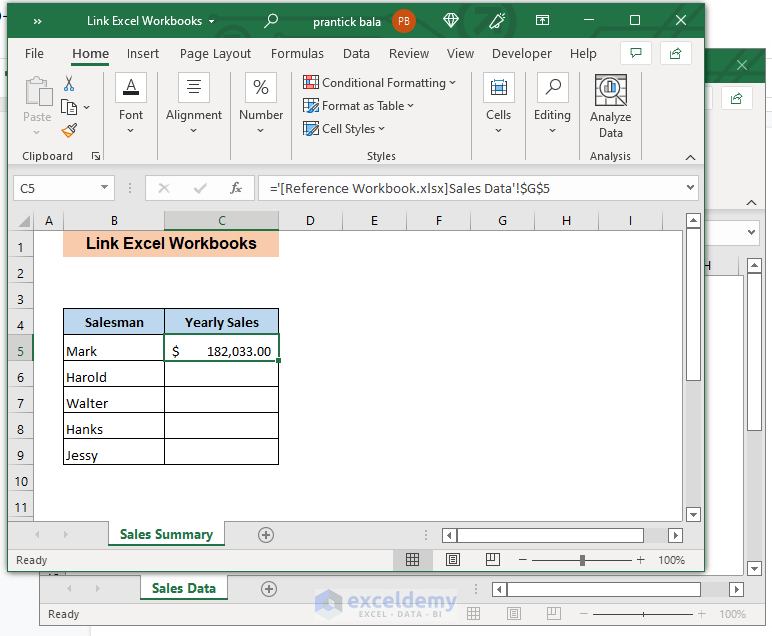Link Excel Sheets in 2016: A Step-by-Step Guide

Whether you're managing a business or keeping track of personal expenses, Excel 2016 is an invaluable tool for organizing data. However, as datasets grow, managing them in separate sheets becomes tedious. Luckily, Excel allows you to link sheets together to streamline your data management and analysis. This guide will walk you through the process of linking Excel sheets in 2016, ensuring your workflow is both efficient and error-free.
Why Link Excel Sheets?

Linking sheets in Excel has several advantages:
- Consolidated Data Management: Simplify updating information in one place, which automatically reflects changes in all linked sheets.
- Reduced Errors: Centralizing updates minimizes the risk of manual errors.
- Enhanced Reporting: Use linked data for comprehensive reports and analyses.
- Streamlined Workflow: Automate data flow between sheets for a more streamlined workflow.
How to Link Excel Sheets

Basic Method: Copy and Paste

Here’s how you can link sheets using the simple copy and paste method:
- Open both the source and destination Excel files.
- In the source file, select the cell or range of cells you want to link.
- Right-click, choose ‘Copy’ or press Ctrl+C.
- Navigate to the destination sheet.
- Right-click where you want to paste the linked data, then select ‘Paste Special’.
- From the dialog box, click on ‘Paste Link’. Your data will now be linked.
- =Sheet1!A1 links to cell A1 from ‘Sheet1’ in the same workbook.
- To link to a different workbook, use:
=[WorkBookName]Sheet1!A1 - =INDIRECT(“‘” & A1 & “’!B2”) where A1 contains the name of the worksheet, and B2 is the cell you want to reference.
- Breaking Links: Navigate to Data > Edit Links, select the link you wish to break, and choose ‘Break Link’.
- Updating Links: Excel generally updates links automatically. If they’re not updating, you can manually update through Data > Edit Links > Update Values.
- Naming Conventions: Use clear, descriptive names for cells, ranges, and sheets to make linking easier.
- Structure: Organize your workbook in a logical manner to facilitate linking.
- Link Cautions: Be aware of potential pitfalls, like linking to volatile data or external workbooks which might be unavailable.
- Backup: Always keep backups as linking multiple sheets can increase complexity and potential for errors.
- Testing: After setting up your links, test for accuracy by updating the source data and verifying the linked data reflects these changes.
🔍 Note: When you paste a link, Excel creates a formula that references the original cell in the source sheet. If the source data changes, the linked data updates automatically.
Advanced Method: Use Formulas

For more control or to link specific cell references, use Excel formulas:
💡 Note: The workbook being linked to must be open, or Excel will ask you to provide the path to the file.
Dynamic Linking: INDIRECT Function

For even more dynamic linking, you can use the INDIRECT function:
Managing Links

Once your sheets are linked, managing and updating them efficiently becomes crucial:
🛑 Note: Breaking links will convert the dynamic data into static values, preventing further updates from the source.
Best Practices for Linking Sheets

Linking Excel sheets in 2016 is a powerful feature that can revolutionize how you manage and analyze data. By linking sheets, you can significantly reduce the time spent on manual data entry, minimize errors, and ensure your data remains current across all relevant spreadsheets. With the methods outlined in this guide, you should now feel confident in implementing a linked Excel sheet system. Remember, while linking is efficient, regular backups and careful data management are key to keeping your spreadsheet ecosystem reliable and robust.
How do I know if a cell in my sheet is linked to another sheet?

+
You can use the Excel feature ‘Trace Precedents’ or ‘Trace Dependents’ from the Formulas tab. Trace Precedents will show arrows to cells that affect the currently selected cell, while Trace Dependents will highlight where the selected cell’s value is used.
Can I link data from an Excel sheet to an external source?

+
Yes, you can link data from an Excel sheet to various external sources like databases or web services. Excel’s Power Query feature is particularly useful for this task, allowing you to establish dynamic connections to external data.
What happens if the source workbook is not available when I open the destination workbook?

+
Excel will prompt you with an option to update the links when you open the destination workbook. If you choose not to update, the linked data will not change and will display the last known values from the source. You can manually update the links later when the source becomes available.